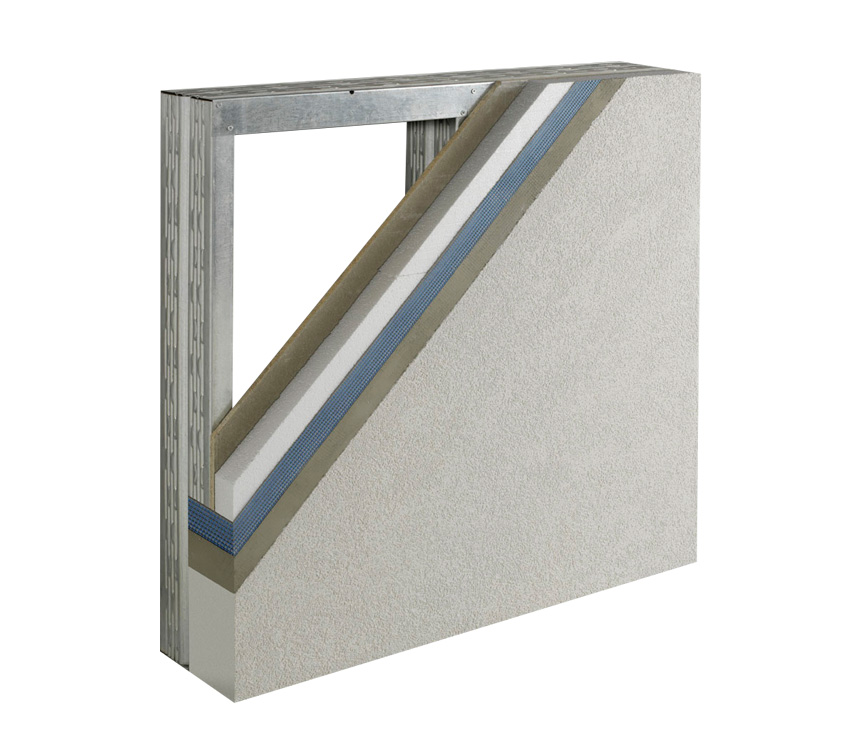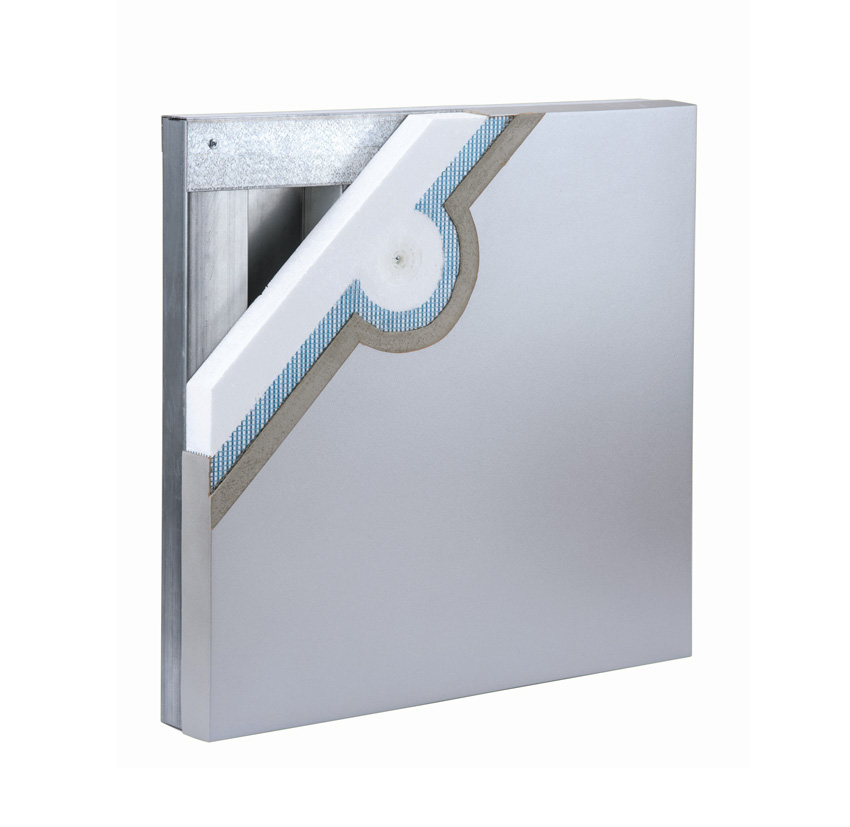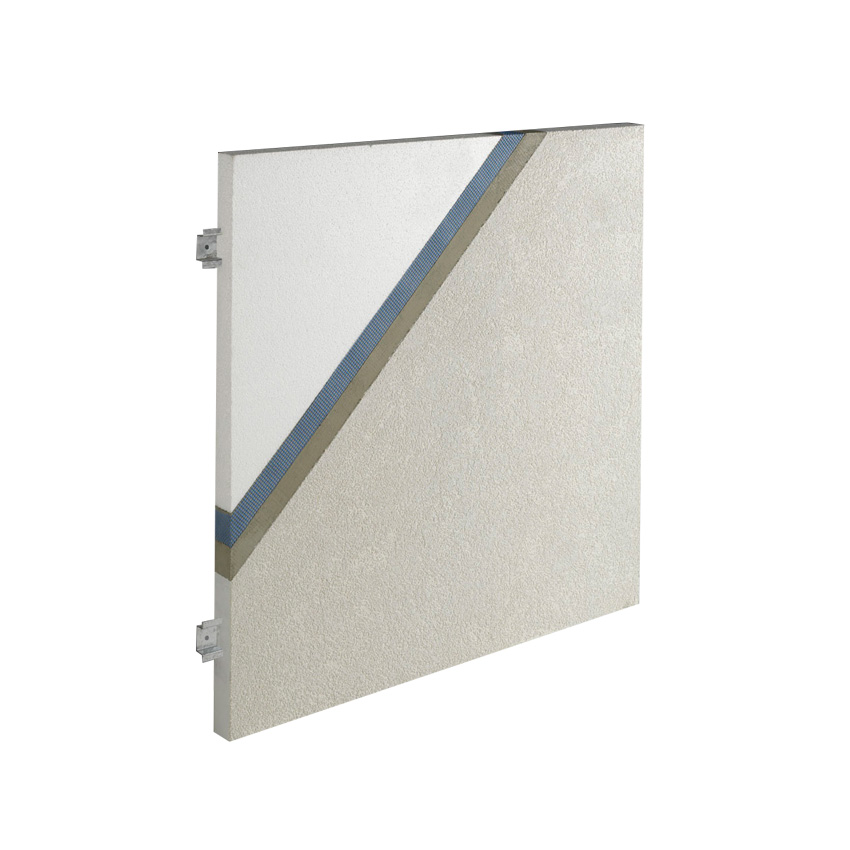Prefabricated EIFS-Clad Wall Panel Assemblies
Full Steel-Stud Composite Panels
The most common type of prefabricated EIFS panel assembly has traditionally been a full steel-stud composite panel system. These very complete panels are composed first of steel-stud framing covered with exterior sheathing. Next, AWRBs and flashing for rough openings or wall penetrations are installed to create the needed air and water resistance. Then, adhesive, and continuous insulation boards are installed on top. Finally, a reinforced base coat is applied followed by a selected textured finish coating. This panel type represents one entire exterior wall envelope assembly with the full combination of multiple trades, materials, and their necessary coordination.

Full steel-stud composite panels are the most common and most complete type of panels with framing, sheathing, insulation, AWRB, and finishing system all fabricated in advance.
Full steel-stud composite panels are very flexible in regards to orientation and size, with the only size restrictions being those of trucking capabilities, roadway or delivery route restrictions, site logistics or access and erection requirements. They are commonly fabricated in sizes ranging from 8, 10, or 12 feet wide and up to 50 feet long depending on the trucking arrangement used. Full steel-stud composite EIFS panels are typically designed and fabricated with barrier or non-drainage type EIFS claddings; however, drainage capacity can be incorporated on an individual-panel basis. This would require the development of weep detailing at horizontal termination conditions, such as the head joints of wall-penetration components like windows, doors or louvers as well as at the bottom horizontal panel joint. Because this panel type includes the metal studs and sheathing, it has complete and inherent structural integrity. Typically, it is the EIFS panel fabricator who coordinates the detailed design and engineering of the panels and structural connections in accordance with the architectural drawings and specifications.
Framed openings for windows and other envelope components can be designed into the panels, and, in many cases, those components can be integrated and preinstalled within the panel.
Full steel-stud composite panels represent a collection of wall envelope components that are independent of each other but function as one. Once the panels are shipped to the job site, they are put in place using a crane and welded or mechanically fastened to the existing steel frame or prepared slab edge of the building structure. Traditionally, full stud composite panels are designed and installed in a “balloon framing” manor that extends past multiple floor plates, dramatically simplifying and accelerating building envelope construction. This approach provides continuous insulation across the floor slab edge and overcomes another thermal bridging condition. It also moves the metal framing outside of the slab edge, creating more usable interior square footage which may translate to increased lease revenue for a building owner. As in all balloon framing situations, however, fire stopping and sealing at floor slab edges may be required to prevent vertical spread of fire in the assembly.
Alternatively, full steel-stud composite panels can be installed in a “platform framing” process where the metal framing for each story rest on the floor structure. Treatment of the slab face can be addressed in several ways. Either platform or balloon framing allow large and intricate panel designs to be quickly and easily incorporated onto the building’s exterior, which is the hallmark of what prefabricated EIFS panels can accomplish.
Galvanized Corrugated Steel-Deck-Backed Panel
A second and unique panel fabrication option uses EIFS applied to a galvanized corrugated steel decking substrate with a galvanized steel channel perimeter framing. This option is most ideally suited for rooftop screen walls around mechanical equipment or other similar conditions that need attention to control the overall building appearance. This fabrication allows for the backside of the panel assembly to be left exposed to the weather and elements but can be styled and finished on the front to match the remainder of the building’s architectural character. This panel option does not require a sheathing layer substrate, and the EIF system is attached directly to the steel deck using mechanical fasteners. These types of panels are usually much lighter and thinner than the traditional full steel-stud composite EIFS panels, which make them much easier to transport and install onto an open structural column and beam frame. Steel decking substrates are generally non-loadbearing and would therefore require additional framing support for windows, doors, louvers, or other wall-penetration components. Corrugated steel-deck-backed panels are available in sizes comparable to full steel-stud panels.

Galvanized corrugated steel-deck-backed panels are ideally suited for walls that mask or cover other things, such as rooftop HVAC equipment.
Lightweight Channel-Reinforced Insulation
One of the most unique prefabricated EIFS panel options is a simple, lightweight, channel-reinforced insulation panel. Lightweight EIFS panels do not include all of the integral framing, sheathing, or structure needed for other EIFS panel types. Therefore, they require that a wall assembly and substrate are in place to which the panels can be attached, making them particularly well-suited for retrofit or renovation construction projects. As a result of their reduced structural makeup, these panels are generally smaller in size at approximately 10 feet by 12 or 14 feet, making them lighter in weight and easier to install. In this type of panel, metal hat channels are inserted and glued into the back of expanded polystyrene (EPS) continuous insulation board to give it added structural stability during handling and erection. Once the panels are completed and the EIFS is cured, they are brought to the job site and installed onto a new or existing wall substrate using either an adhesive, mechanical fastening, bearing clips, or a combination of the three as determined through engineering. The new or existing substrate can also be prepared with the EIFS manufacturer’s fluid-applied AWRB barrier coating, allowing the panels to be installed as a moisture drainage assembly.

Lightweight channel-reinforced panels are ideal for both new construction and retrofit projects to create consistent, high-performance wall assemblies.
It should be noted that lightweight, channel-reinforced insulation panels type are ideal for both new and retrofit constructions. In new construction, they allow a quicker installation of the facade system compared to other systems. For retrofit situations, their lightweight nature means that the existing building structure can likely accommodate the new system easily, while their thin profile means they can integrate with existing building systems and set back requirements. Additionally, the concept of lightweight channel-reinforced EIFS panels can be applied to smaller shapes that are made of coated and finished EPS insulation. Such shaped sections can be fabricated and installed as a building feature, such as a new cornice or raised band onto an existing facade surface.
Panel Joint Treatment
Regardless of the panel type used, joints between panels need to be addressed. EIFS were originally designed and engineered as a face-sealed cladding assembly, meaning that all edges need to be properly sealed so no incidental moisture can pass through or around the edge of an EIFS cladding. This original, inherent engineering feature remains in place for current EIFS claddings, including prefabricated panels. In the case of prefabricated EIFS panels, most EIFS manufacturers will provide a list of sealants that have been tested and approved for compatibility. Also, most sealant manufacturers will perform project-specific compatibility testing if required.
Different EIFS panel types will have different criteria respective to panel joints. Full steel-stud composite panels have panel joints that generally extend through the full wall thickness. For this panel type, it is good design practice to include a double line of sealants at these panel joint locations. This double joint will be comprised of two individual backer rod and sealant joints set one on top of the other, providing redundancy in the event of a breach of the outer layer. This allows the owner time to repair the breach before water can penetrate into the interior of the building. It also eliminates UV exposure of the inner seal and can be configured to accommodate drainage within the joint itself.
Sealant joints should be properly designed for joint width, depth, and modulus of elasticity to specifically accommodate the expected movement between panels without overstressing the materials. A good rule of thumb is to design the sealant joint width to be not less than four times the expected movement and not less than ¾ inch. Seismic requirements may be larger. Some fabricators also incorporate a gasket system to seal panel to panel joints. Always verify with the manufacturer that the selected sealant or gasket has been tested for compatibility and can accommodate the expected movements.
One other consideration is the option of using horizontal shiplap joints in panels. This is especially appropriate in lightweight channel-reinforced panels that can be shaped to form the upper and lower shiplap profiles. The advantage of this approach is a significantly reduced lineal footage of sealant with less maintenance potential. A shiplap joint may still have sealant or a compression gasket, but it would all be concealed and not exposed to UV or other degrading elements.









